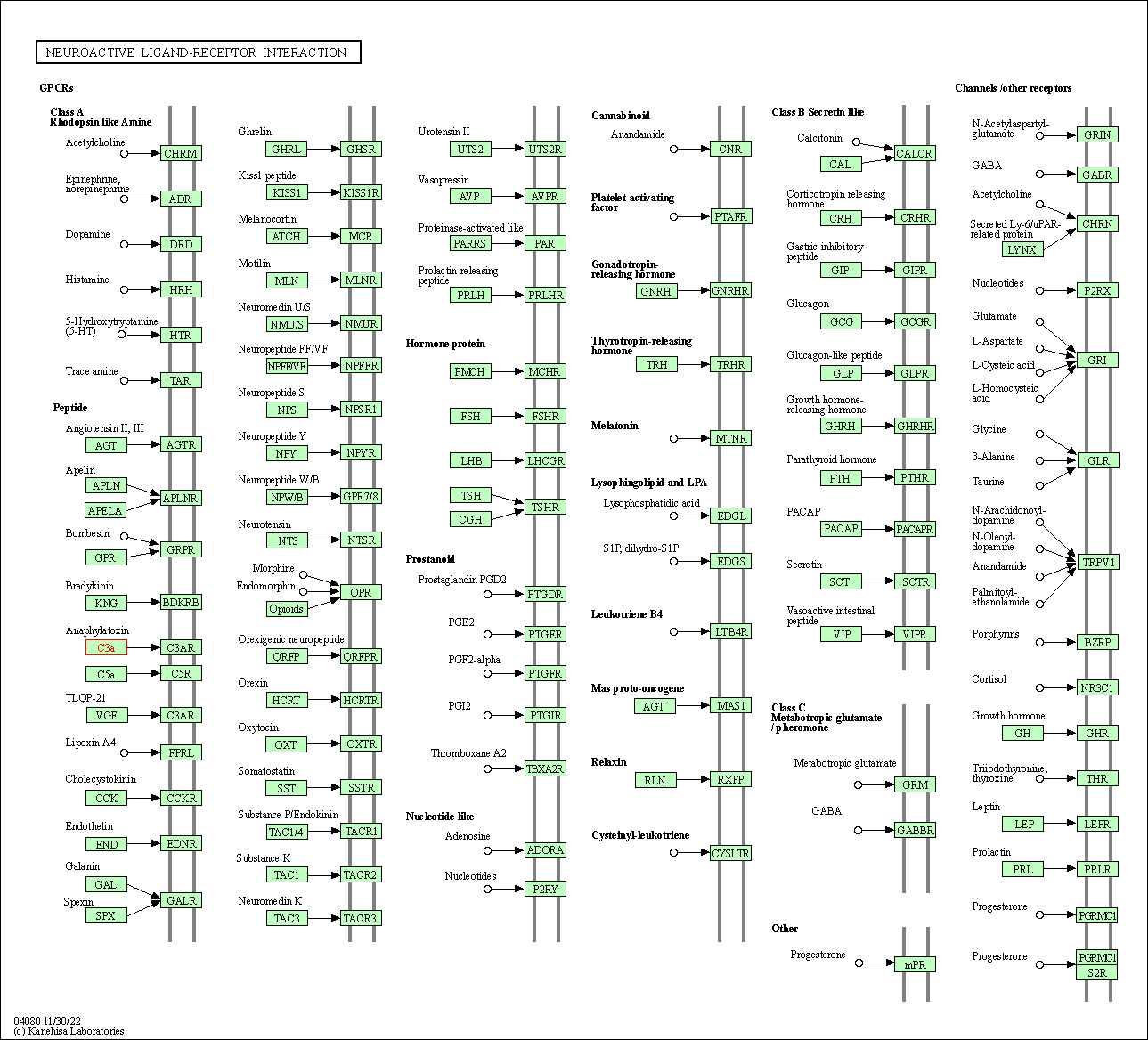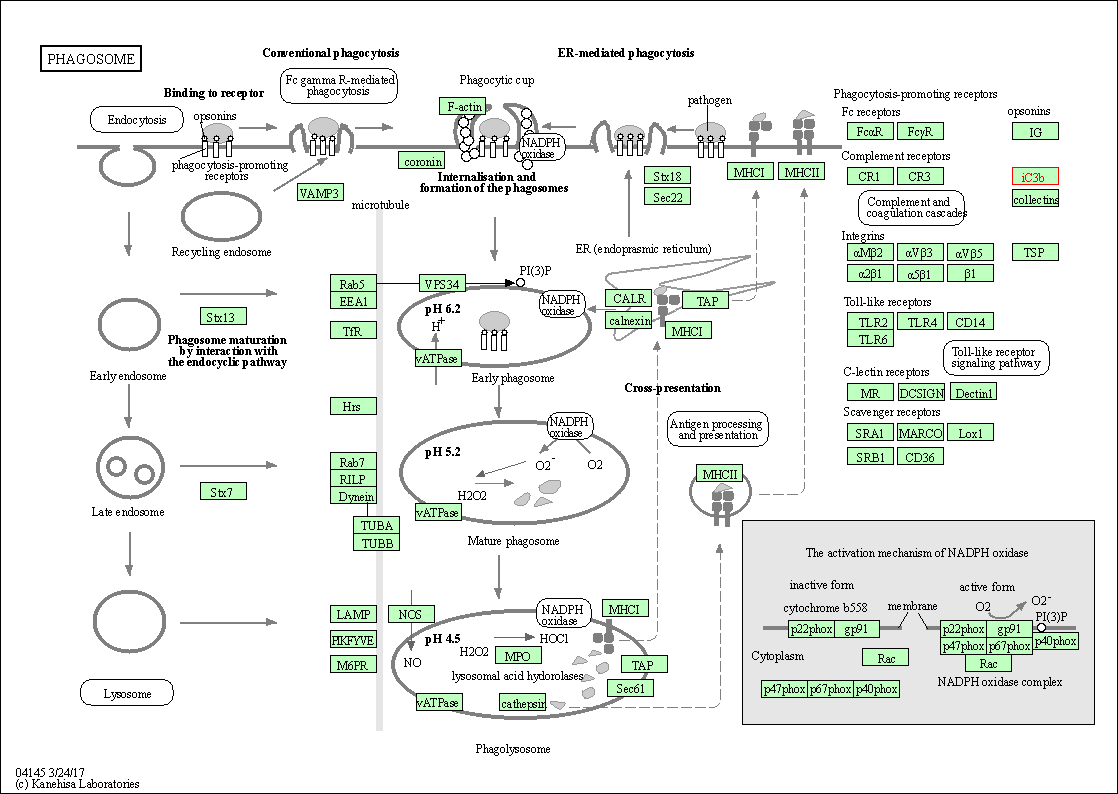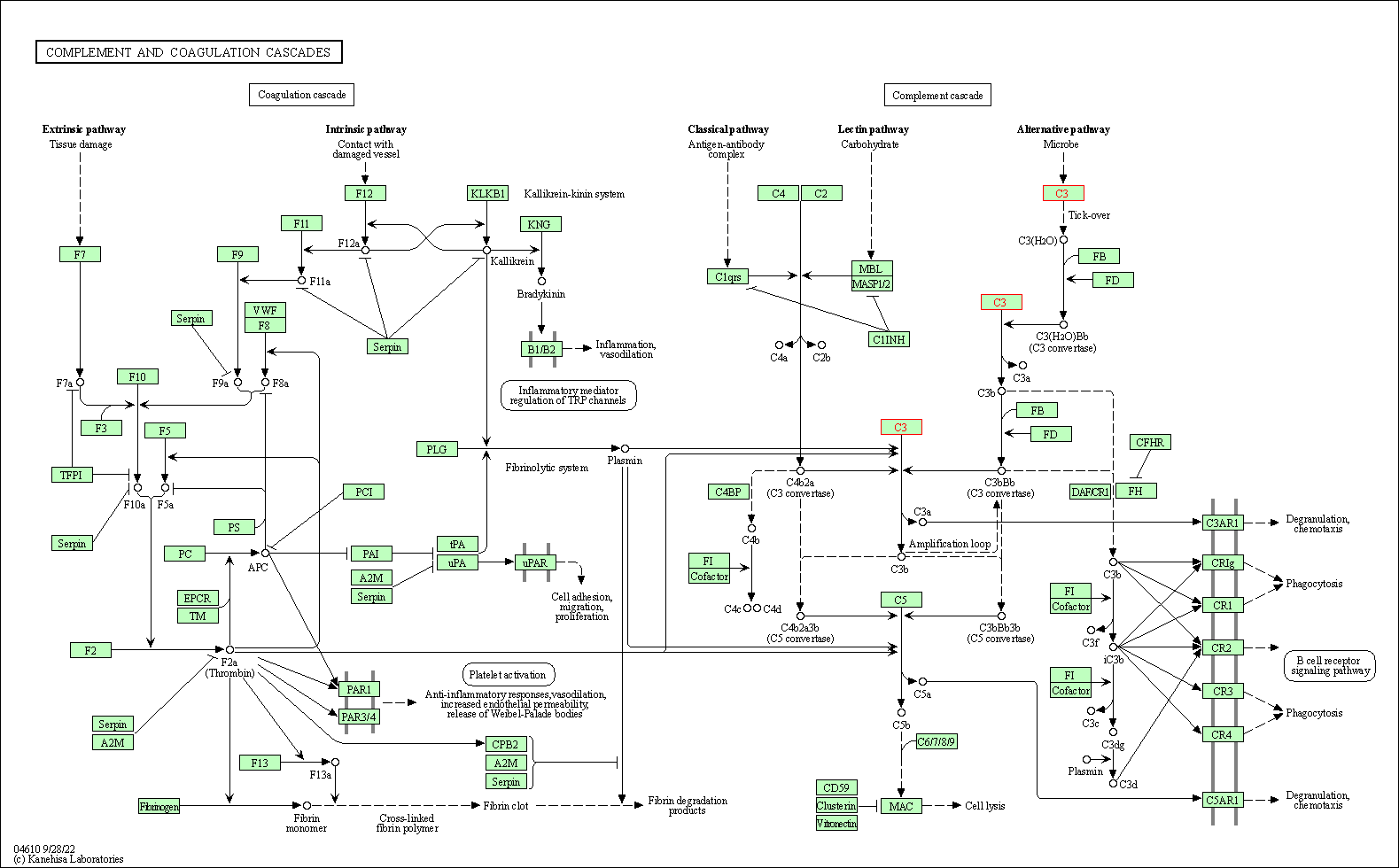Target Information
| Target General Information | Top | |||||
|---|---|---|---|---|---|---|
| Target ID |
T26851
(Former ID: TTDR01153)
|
|||||
| Target Name |
Complement C3 (CO3)
|
|||||
| Synonyms |
C3 and PZP-like alpha-2-macroglobulin domain-containing protein 1; C3
Click to Show/Hide
|
|||||
| Gene Name |
C3
|
|||||
| Target Type |
Successful target
|
[1] | ||||
| Disease | [+] 1 Target-related Diseases | + | ||||
| 1 | Haemolytic anemia [ICD-11: 3A20-3A2Z] | |||||
| Function |
Acylation stimulating protein: adipogenic hormone that stimulates triglyceride (TG) synthesis and glucose transport in adipocytes, regulating fat storage and playing a role in postprandial TG clearance. Appears to stimulate TG synthesis via activation of the PLC, MAPK and AKT signaling pathways. Ligand for C5AR2. Promotes the phosphorylation, ARRB2-mediated internalization and recycling of C5AR2 (PubMed:8376604, PubMed:2909530, PubMed:9059512, PubMed:10432298, PubMed:15833747, PubMed:16333141, PubMed:19615750).
Click to Show/Hide
|
|||||
| BioChemical Class |
Complement system
|
|||||
| UniProt ID | ||||||
| Sequence |
MGPTSGPSLLLLLLTHLPLALGSPMYSIITPNILRLESEETMVLEAHDAQGDVPVTVTVH
DFPGKKLVLSSEKTVLTPATNHMGNVTFTIPANREFKSEKGRNKFVTVQATFGTQVVEKV VLVSLQSGYLFIQTDKTIYTPGSTVLYRIFTVNHKLLPVGRTVMVNIENPEGIPVKQDSL SSQNQLGVLPLSWDIPELVNMGQWKIRAYYENSPQQVFSTEFEVKEYVLPSFEVIVEPTE KFYYIYNEKGLEVTITARFLYGKKVEGTAFVIFGIQDGEQRISLPESLKRIPIEDGSGEV VLSRKVLLDGVQNPRAEDLVGKSLYVSATVILHSGSDMVQAERSGIPIVTSPYQIHFTKT PKYFKPGMPFDLMVFVTNPDGSPAYRVPVAVQGEDTVQSLTQGDGVAKLSINTHPSQKPL SITVRTKKQELSEAEQATRTMQALPYSTVGNSNNYLHLSVLRTELRPGETLNVNFLLRMD RAHEAKIRYYTYLIMNKGRLLKAGRQVREPGQDLVVLPLSITTDFIPSFRLVAYYTLIGA SGQREVVADSVWVDVKDSCVGSLVVKSGQSEDRQPVPGQQMTLKIEGDHGARVVLVAVDK GVFVLNKKNKLTQSKIWDVVEKADIGCTPGSGKDYAGVFSDAGLTFTSSSGQQTAQRAEL QCPQPAARRRRSVQLTEKRMDKVGKYPKELRKCCEDGMRENPMRFSCQRRTRFISLGEAC KKVFLDCCNYITELRRQHARASHLGLARSNLDEDIIAEENIVSRSEFPESWLWNVEDLKE PPKNGISTKLMNIFLKDSITTWEILAVSMSDKKGICVADPFEVTVMQDFFIDLRLPYSVV RNEQVEIRAVLYNYRQNQELKVRVELLHNPAFCSLATTKRRHQQTVTIPPKSSLSVPYVI VPLKTGLQEVEVKAAVYHHFISDGVRKSLKVVPEGIRMNKTVAVRTLDPERLGREGVQKE DIPPADLSDQVPDTESETRILLQGTPVAQMTEDAVDAERLKHLIVTPSGCGEQNMIGMTP TVIAVHYLDETEQWEKFGLEKRQGALELIKKGYTQQLAFRQPSSAFAAFVKRAPSTWLTA YVVKVFSLAVNLIAIDSQVLCGAVKWLILEKQKPDGVFQEDAPVIHQEMIGGLRNNNEKD MALTAFVLISLQEAKDICEEQVNSLPGSITKAGDFLEANYMNLQRSYTVAIAGYALAQMG RLKGPLLNKFLTTAKDKNRWEDPGKQLYNVEATSYALLALLQLKDFDFVPPVVRWLNEQR YYGGGYGSTQATFMVFQALAQYQKDAPDHQELNLDVSLQLPSRSSKITHRIHWESASLLR SEETKENEGFTVTAEGKGQGTLSVVTMYHAKAKDQLTCNKFDLKVTIKPAPETEKRPQDA KNTMILEICTRYRGDQDATMSILDISMMTGFAPDTDDLKQLANGVDRYISKYELDKAFSD RNTLIIYLDKVSHSEDDCLAFKVHQYFNVELIQPGAVKVYAYYNLEESCTRFYHPEKEDG KLNKLCRDELCRCAEENCFIQKSDDKVTLEERLDKACEPGVDYVYKTRLVKVQLSNDFDE YIMAIEQTIKSGSDEVQVGQQRTFISPIKCREALKLEEKKHYLMWGLSSDFWGEKPNLSY IIGKDTWVEHWPEEDECQDEENQKQCQDLGAFTESMVVFGCPN Click to Show/Hide
|
|||||
| 3D Structure | Click to Show 3D Structure of This Target | AlphaFold | ||||
| HIT2.0 ID | T19YQS | |||||
| Drugs and Modes of Action | Top | |||||
|---|---|---|---|---|---|---|
| Approved Drug(s) | [+] 1 Approved Drugs | + | ||||
| 1 | Pegcetacoplan | Drug Info | Approved | Paroxysmal nocturnal haemoglobinuria | [2] | |
| Clinical Trial Drug(s) | [+] 2 Clinical Trial Drugs | + | ||||
| 1 | Imprime PGG | Drug Info | Phase 2/3 | Non-hodgkin lymphoma | [3] | |
| 2 | POT-4 | Drug Info | Phase 2 | Macular degeneration | [6] | |
| Mode of Action | [+] 2 Modes of Action | + | ||||
| Inhibitor | [+] 26 Inhibitor drugs | + | ||||
| 1 | Pegcetacoplan | Drug Info | [1] | |||
| 2 | POT-4 | Drug Info | [8] | |||
| 3 | Ac-ICV(1MeW)QDWGAHRCT-NH2 | Drug Info | [9] | |||
| 4 | Ac-ICV(5fW)QDWGAHRCT-NH2 | Drug Info | [9] | |||
| 5 | Ac-ICVWQD(5fW)GAHRCT-NH2 | Drug Info | [9] | |||
| 6 | Ac-ICVWQDWGAHRCT-NH2 | Drug Info | [9] | |||
| 7 | Ac-I[CV(1Nal)QDWGAHRC]T | Drug Info | [10] | |||
| 8 | Ac-I[CV(2Igl)QDWGAHRC]T | Drug Info | [10] | |||
| 9 | Ac-I[CV(2Nal)QDWGAHRC]T | Drug Info | [10] | |||
| 10 | Ac-I[CV(2Nal)QDWGAHRC]T-NH2 | Drug Info | [10] | |||
| 11 | Ac-I[CV(Bpa)QDWGAHRC]T | Drug Info | [10] | |||
| 12 | Ac-I[CV(Bpa)QDWGAHRC]T-NH2 | Drug Info | [10] | |||
| 13 | Ac-I[CV(Bta)QDWGAHRC]T | Drug Info | [10] | |||
| 14 | Ac-I[CV(Bta)QDWGAHRC]T-NH2 | Drug Info | [10] | |||
| 15 | Ac-I[CV(Dht)QDWGAHRC]T | Drug Info | [10] | |||
| 16 | Ac-I[CV(Yphs)QDWGAHRC]I-NH2 | Drug Info | [10] | |||
| 17 | Ac-I[CVFQDWGHHRC]T-NH2 | Drug Info | [10] | |||
| 18 | Ac-I[CVHQDWGHHRC]T-NH2 | Drug Info | [10] | |||
| 19 | Ac-I[CVSQDWGHHRC]T-NH2 | Drug Info | [10] | |||
| 20 | Ac-I[CVTQDWGHHRC]T-NH2 | Drug Info | [10] | |||
| 21 | Ac-I[CVVQDWGAHRC]T-NH2 | Drug Info | [10] | |||
| 22 | Ac-I[CVWQDWG(Abu)HRC]T-NH2 | Drug Info | [10] | |||
| 23 | Ac-I[CVWQDWGAHRC]dT | Drug Info | [10] | |||
| 24 | Ac-I[CVWQDWGAHRC]T | Drug Info | [10] | |||
| 25 | Ac-I[CVWQDWGHHRC]T-NH2 | Drug Info | [10] | |||
| 26 | Ac-I[CVWQDWGWHRC]T-NH2 | Drug Info | [10] | |||
| Modulator | [+] 1 Modulator drugs | + | ||||
| 1 | Imprime PGG | Drug Info | [7] | |||
| Cell-based Target Expression Variations | Top | |||||
|---|---|---|---|---|---|---|
| Cell-based Target Expression Variations | ||||||
| Drug Binding Sites of Target | Top | |||||
|---|---|---|---|---|---|---|
| Ligand Name: 1-methyl-L-tryptophan | Ligand Info | |||||
| Structure Description | C3b in complex with CP40 | PDB:7BAG | ||||
| Method | X-ray diffraction | Resolution | 2.00 Å | Mutation | No | [11] |
| PDB Sequence |
SPMYSIITPN
10 ILRLESEETM20 VLEAHDAQGD30 VPVTVTVHDF40 PGKKLVLSSE50 KTVLTPATNH 60 MGNVTFTIPA70 NREFKKGRNK82 FVTVQATFGT92 QVVEKVVLVS102 LQSGYLFIQT 112 DKTIYTPGST122 VLYRIFTVNH132 KLLPVGRTVM142 VNIENPEGIP152 VKQDSLSSQN 162 QLGVLPLSWD172 IPELVNMGQW182 KIRAYYENSP192 QQVFSTEFEV202 KEYVLPSFEV 212 IVEPTEKFYY222 IYNEKGLEVT232 ITARFLYGKK242 VEGTAFVIFG252 IQDGEQRISL 262 PESLKRIPIE272 DGSGEVVLSR282 KVLLDGVQNP292 RAEDLVGKSL302 YVSATVILHS 312 GSDMVQAERS322 GIPIVTSPYQ332 IHFTKTPKYF342 KPGMPFDLMV352 FVTNPDGSPA 362 YRVPVAVQGE372 DTVQSLTQGD382 GVAKLSINTH392 PSQKPLSITV402 RTKKQELSEA 412 EQATRTMQAL422 PYSTVGNSNN432 YLHLSVLRTE442 LRPGETLNVN452 FLLRMDRAHE 462 AKIRYYTYLI472 MNKGRLLKAG482 RQVREPGQDL492 VVLPLSITTD502 FIPSFRLVAY 512 YTLIGASGQR522 EVVADSVWVD532 VKDSCVGSLV542 VKSGQSEDRQ552 PVPGQQMTLK 562 IEGDHGARVV572 LVAVDKGVFV582 LNKKNKLTQS592 KIWDVVEKAD602 IGCTPGSGKD 612 YAGVFSDAGL622 TFTSSSGQQT632 AQRAELQCPQ642
|
|||||
|
|
||||||
| Ligand Name: Acetamide | Ligand Info | |||||
| Structure Description | C3b in complex with CP40 | PDB:7BAG | ||||
| Method | X-ray diffraction | Resolution | 2.00 Å | Mutation | No | [11] |
| PDB Sequence |
SNLDEDIIAE
736 ENIVSRSEFP746 ESWLWNVEDL756 KEPPKNGIST766 KLMNIFLKDS776 ITTWEILAVS 786 MSDKKGICVA796 DPFEVTVMQD806 FFIDLRLPYS816 VVRNEQVEIR826 AVLYNYRQNQ 836 ELKVRVELLH846 NPAFCSLATT856 KRRHQQTVTI866 PPKSSLSVPY876 VIVPLKTGLQ 886 EVEVKAAVYH896 HFISDGVRKS906 LKVVPEGIRM916 NKTVAVRTLD926 PERLGREGVQ 936 KEDIPPADLS946 DQVPDTESET956 RILLQGTPVA966 QMTEDAVDAE976 RLKHLIVTPS 986 GCGEQNMIGM996 TPTVIAVHYL1006 DETEQWEKFG1016 LEKRQGALEL1026 IKKGYTQQLA 1036 FRQPSSAFAA1046 FVKRAPSTWL1056 TAYVVKVFSL1066 AVNLIAIDSQ1076 VLCGAVKWLI 1086 LEKQKPDGVF1096 QEDAPVIHQE1106 MIGGLRNNNE1116 KDMALTAFVL1126 ISLQEAKDIC 1136 EEQVNSLPGS1146 ITKAGDFLEA1156 NYMNLQRSYT1166 VAIAGYALAQ1176 MGRLKGPLLN 1186 KFLTTAKDKN1196 RWEDPGKQLY1206 NVEATSYALL1216 ALLQLKDFDF1226 VPPVVRWLNE 1236 QRYYGGGYGS1246 TQATFMVFQA1256 LAQYQKDAPD1266 HQELNLDVSL1276 QLPSRSSKIT 1286 HRIHWESASL1296 LRSEETKENE1306 GFTVTAEGKG1316 QGTLSVVTMY1326 HAKAKDQLTC 1336 NKFDLKVTIK1346 PAPETEKRPQ1356 DAKNTMILEI1366 CTRYRGDQDA1376 TMSILDISMM 1386 TGFAPDTDDL1396 KQLANGVDRY1406 ISKYELDKAF1416 SDRNTLIIYL1426 DKVSHSEDDC 1436 LAFKVHQYFN1446 VELIQPGAVK1456 VYAYYNLEES1466 CTRFYHPEKE1476 DGKLNKLCRD 1486 ELCRCAEENC1496 FIQKSDDKVT1506 LEERLDKACE1516 PGVDYVYKTR1526 LVKVQLSNDF 1536 DEYIMAIEQT1546 IKSGSDEVQV1556 GQQRTFISPI1566 KCREALKLEE1576 KKHYLMWGLS 1586 SDFWGEKPNL1596 SYIIGKDTWV1606 EHWPEEDECQ1616 DEENQKQCQD1626 LGAFTESMVV 1636 FGCPN
|
|||||
|
|
||||||
| Click to View More Binding Site Information of This Target with Different Ligands | ||||||
| Different Human System Profiles of Target | Top |
|---|---|
|
Human Similarity Proteins
of target is determined by comparing the sequence similarity of all human proteins with the target based on BLAST. The similarity proteins for a target are defined as the proteins with E-value < 0.005 and outside the protein families of the target.
A target that has fewer human similarity proteins outside its family is commonly regarded to possess a greater capacity to avoid undesired interactions and thus increase the possibility of finding successful drugs
(Brief Bioinform, 21: 649-662, 2020).
Human Tissue Distribution
of target is determined from a proteomics study that quantified more than 12,000 genes across 32 normal human tissues. Tissue Specificity (TS) score was used to define the enrichment of target across tissues.
The distribution of targets among different tissues or organs need to be taken into consideration when assessing the target druggability, as it is generally accepted that the wider the target distribution, the greater the concern over potential adverse effects
(Nat Rev Drug Discov, 20: 64-81, 2021).
Human Pathway Affiliation
of target is determined by the life-essential pathways provided on KEGG database. The target-affiliated pathways were defined based on the following two criteria (a) the pathways of the studied target should be life-essential for both healthy individuals and patients, and (b) the studied target should occupy an upstream position in the pathways and therefore had the ability to regulate biological function.
Targets involved in a fewer pathways have greater likelihood to be successfully developed, while those associated with more human pathways increase the chance of undesirable interferences with other human processes
(Pharmacol Rev, 58: 259-279, 2006).
Biological Network Descriptors
of target is determined based on a human protein-protein interactions (PPI) network consisting of 9,309 proteins and 52,713 PPIs, which were with a high confidence score of ≥ 0.95 collected from STRING database.
The network properties of targets based on protein-protein interactions (PPIs) have been widely adopted for the assessment of target’s druggability. Proteins with high node degree tend to have a high impact on network function through multiple interactions, while proteins with high betweenness centrality are regarded to be central for communication in interaction networks and regulate the flow of signaling information
(Front Pharmacol, 9, 1245, 2018;
Curr Opin Struct Biol. 44:134-142, 2017).
Human Similarity Proteins
Human Tissue Distribution
Human Pathway Affiliation
Biological Network Descriptors
|
|
|
There is no similarity protein (E value < 0.005) for this target
|
|
Note:
If a protein has TS (tissue specficity) scores at least in one tissue >= 2.5, this protein is called tissue-enriched (including tissue-enriched-but-not-specific and tissue-specific). In the plots, the vertical lines are at thresholds 2.5 and 4.
|
| KEGG Pathway | Pathway ID | Affiliated Target | Pathway Map |
|---|---|---|---|
| Neuroactive ligand-receptor interaction | hsa04080 | Affiliated Target |

|
| Class: Environmental Information Processing => Signaling molecules and interaction | Pathway Hierarchy | ||
| Phagosome | hsa04145 | Affiliated Target |

|
| Class: Cellular Processes => Transport and catabolism | Pathway Hierarchy | ||
| Complement and coagulation cascades | hsa04610 | Affiliated Target |

|
| Class: Organismal Systems => Immune system | Pathway Hierarchy | ||
| Neutrophil extracellular trap formation | hsa04613 | Affiliated Target |

|
| Class: Organismal Systems => Immune system | Pathway Hierarchy | ||
| Degree | 23 | Degree centrality | 2.47E-03 | Betweenness centrality | 2.61E-03 |
|---|---|---|---|---|---|
| Closeness centrality | 1.89E-01 | Radiality | 1.32E+01 | Clustering coefficient | 4.35E-02 |
| Neighborhood connectivity | 6.61E+00 | Topological coefficient | 6.52E-02 | Eccentricity | 13 |
| Download | Click to Download the Full PPI Network of This Target | ||||
| Chemical Structure based Activity Landscape of Target | Top |
|---|---|
| Target Poor or Non Binders | Top | |||||
|---|---|---|---|---|---|---|
| Target Poor or Non Binders | ||||||
| Target Regulators | Top | |||||
|---|---|---|---|---|---|---|
| Target-interacting Proteins | ||||||
| Target-Related Models and Studies | Top | |||||
|---|---|---|---|---|---|---|
| Target Validation | ||||||
| References | Top | |||||
|---|---|---|---|---|---|---|
| REF 1 | Anti-ageing pipeline starts to mature.Nat Rev Drug Discov. 2018 Sep;17(9):609-612. | |||||
| REF 2 | FDA Approved Drug Products from FDA Official Website. 2023. Application Number: 215014. | |||||
| REF 3 | Trusted, scientifically sound profiles of drug programs, clinical trials, safety reports, and company deals, written by scientists. Springer. 2015. Adis Insight (drug id 800024408) | |||||
| REF 4 | Clinical pipeline report, company report or official report of Amyndas. | |||||
| REF 5 | ClinicalTrials.gov (NCT04465955) A Phase 2 Multicenter, Randomized, Double-Masked, Sham-Controlled Study of the Safety and Efficacy of Intravitreal Injections of NGM621 in Subjects With Geographic Atrophy (GA) Secondary to Age-Related Macular Degeneration (AMD). U.S.National Institutes of Health. | |||||
| REF 6 | ClinicalTrials.gov (NCT01157065) Evaluation of AL-78898A in Exudative Age-Related Macular Degeneration. U.S. National Institutes of Health. | |||||
| REF 7 | National Cancer Institute Drug Dictionary (drug id 599816). | |||||
| REF 8 | Compstatin: A Complement Inhibitor on its Way to Clinical Application. Adv Exp Med Biol. 2008; 632: 273-292. | |||||
| REF 9 | Hydrophobic effect and hydrogen bonds account for the improved activity of a complement inhibitor, compstatin. J Med Chem. 2006 Jul 27;49(15):4616-22. | |||||
| REF 10 | Design and NMR characterization of active analogues of compstatin containing non-natural amino acids. J Med Chem. 2005 Jan 13;48(1):274-86. | |||||
| REF 11 | Insight into mode-of-action and structural determinants of the compstatin family of clinical complement inhibitors. Nat Commun. 2022 Sep 20;13(1):5519. | |||||
If You Find Any Error in Data or Bug in Web Service, Please Kindly Report It to Dr. Zhou and Dr. Zhang.

